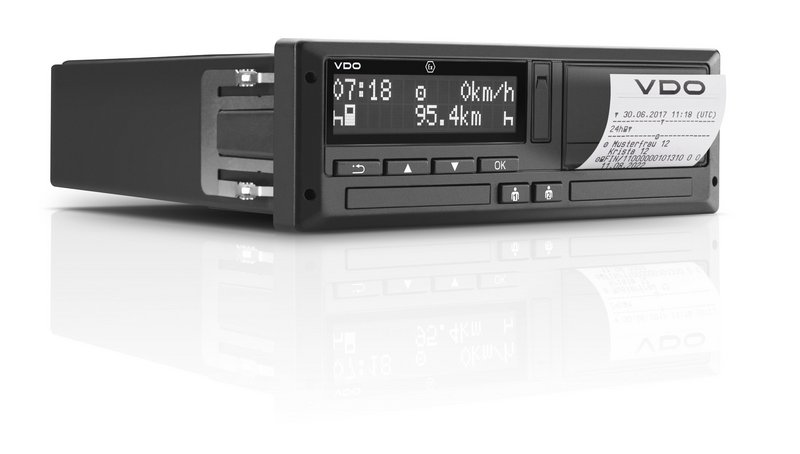Ready for Logistics 4.0 – the intelligent tachograph from Continental is a lot more than a black box
- The new DTCO 4.0 digital tachograph brings trusted data into seamless supply and information chains
- A DSRC (Dedicated Short Range Communication) interface and a satellite link network the device – using the highest security standards
- An Intelligent Transportation Systems (ITS) interface supports transport planning and enables cooperating services
- Continental has also implemented the upcoming EU Regulation 165/2014 in the DTCO 4.0
Villingen-Schwenningen, July 5, 2018. The new Tachograph Regulation (EU) 165/2014 comes into force in mid-2019. All newly registered trucks will then have an intelligent digital tachograph on board – and this will bring many functional enhancements. Linking to a satellite positioning system and transmitting data wirelessly during roadside checks make life easier for trucking companies and law enforcement authorities – and new encryption ensures an even greater level of security. Dr. Lutz Scholten, Vice President of Segment Tachographs, Telematics and Services at Continental, emphasizes that the new generation of the DTCO means no less than the entry into a new era of secure data acquisition. “The tachograph is now becoming a comprehensive, authenticated data source for all telematics processes.”
The new tachograph era enables new services and business models
The tachograph experts at the technology company Continental have long since regarded the DTCO as being a lot more than a black box. “Telematics data can be compared to uncut diamonds: they have great potential, but in many cases they simply aren’t available in a form on which you can build business relationships, because they are not sufficiently trustworthy and authenticated,” says Dr. Lutz Scholten. The DTCO 4.0 solves this problem, because it can collect, validate and process the acquired data in accordance with the highest security criteria, and exchange it with clearly defined and authorized third parties. “The new tachograph era brings new opportunities for fleets and for their service providers. Countless services and even new business models can now be designed based on data from the DTCO.”
With its VDO brand, Continental has been one of the leading suppliers of tachographs for decades and the company continues to develop tachograph-related services and products in close cooperation with vehicle manufacturers, fleet operators and drivers. Continental has also adapted the download tools, the fleet management solution VDO TIS-Web, test equipment and workshop training courses for the new DTCO 4.0 to the new legal requirements and the new possibilities. The DTCO 4.0 will be officially presented at the IAA Commercial Vehicles trade fair in September 2018.
Unique DSRC antenna technology for wireless data transmission
The EU directive also requires a standardized DSRC interface to make roadside checks more efficient for all those involved. After appropriate authentication, vehicle and calibration data and information about security breaches and malfunctions that have occurred is transmitted wirelessly to the inspection officers’ devices from the DTCO 4.0 in the moving vehicle and inspection officers can then use this data to stop specific vehicles. This change means that companies and drivers who comply with all the regulations can expect fewer unscheduled stops at the roadside.
The DTCO 4.0 transmits the data via its small antenna which is installed on the windshield. Continental is breaking new technological ground here, because instead of installing the complete intelligence for DSRC functionality in the antenna as usual, Continental engineers and leading specialists in industrial microwave technology have now integrated the intelligence in the tachograph itself – and unlike the solutions currently available on the market, no modifications have to be made to the vehicle electrics and electronics. This makes low-cost and problem-free retrofitting possible.
Position information via a GNSS link
The Regulation also makes a link to a global navigation satellite system (GNSS) compulsory. The position information is automatically recorded at the start and the end of the shift, after three hours of driving and after each change of activity. This ensures greater transparency for the roadside control authorities. Position information taken directly from the tachograph can also be used to support fleet management. The DTCO 4.0 supports the European GNSS Galileo, GPS and Glonass.
Increased cryptographic security mechanisms will also be compulsory in the future – and this entails new encryption technology, which also involves communication between the speed sensor and the digital tachograph. Continental has developed the new KITAS sensor 4.0 for this purpose. Together with the DTCO 4.0, it represents a system unit and fulfills the very strict legal requirements. “With the new public-key encryption system, the DTCO 4.0 is already equipped with future-oriented security technology,” explains Dirk Gandras, Program Manager TTS Vehicle Units at Continental. Tachograph card communication will also be encrypted in a new way: in the future, the cards will support two encryption technologies, so existing driver and company cards can be used with the DTCO 4.0 until they expire.
Trusted and authenticated data creates the basis for cooperating services
The world of logistics today is facing great challenges – online trading has fundamentally changed user behavior, the complexity of the logistics chain is increasing, and new mobility concepts are emerging. “Trucking companies and fleet managers must be able to react flexibly in this environment. Digitalization, networking and real-time data will play a key role in the future of the industry,” says Dr. Lutz Scholten. Fleet managers benefit from a standardized ITS (Intelligent Transportation Systems) interface which provides more than 70 different kinds of information from the DTCO 4.0 – and this makes transport planning even more efficient. Legally, the ITS interface is only optional – but Continental has implemented it as standard.
However, fleet service providers and the authorities can also benefit from the new technical possibilities. Direct toll processing is possible with Continental’s DTCO 4.0, for example, even with an integrated, on-board weighing system. Thanks to the integrated DSRC connection, the technical prerequisites for applying country-specific functions for toll billing and toll monitoring in the tachograph are already in place, so the tachograph designers make it possible to dispense with additional on-board units. The toll can also be made fairer at the same time if weight data – collected by sensors on the axles and sent to the tachograph in encrypted form – is simultaneously transmitted. In the future, the actual axle load would then be the decisive factor in the calculation of the toll.
Many other applications are also conceivable if the secure data from the tachograph is passed on to other data processing systems: information about the tank contents, for example, could be determined with secure level sensors and sent to the systems of fuel card companies. Apps could also use information from the DTCO to guide drivers to a nearby gas station or to a parking lot that is accessible at the start of rest periods. Another possibility is to provide the data to service providers for payroll purposes, or to insurance providers for the individual calculation of rates. Continental has already developed interfaces that enable the exchange of authenticated, trustworthy data from the tachograph. The EU General Data Protection Regulation (GDPR) was also addressed during the overall system development. This enables fleet managers and service providers to very quickly identify the tachograph data that is subject to the GDPR and requires the driver’s approval.
The basis for the processing of the tachograph data described here is Continental’s TIS-Web fleet management software. Every possible service is based on the high protection standards of all the data acquired by the tachograph. “With the DTCO 4.0, the amount of GDPR-compliant data with which we can support higher-level fleet management systems in a targeted manner is increasing significantly. This also increases the number of possibilities,” says Dr. Lutz Scholten. “We’re looking forward to supporting the transport industry in its implementation of new ideas with our competence in tachographs and telematics.”

Valerie Libercka
Media Spokesperson Smart Mobility
Continental Automotive

